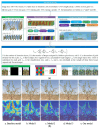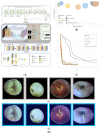A Comprehensive Review of Deep Learning in Computer Vision for Monitoring Apple Tree Growth and Fruit Production
- PMID: 40285123
- PMCID: PMC12031276
- DOI: 10.3390/s25082433
A Comprehensive Review of Deep Learning in Computer Vision for Monitoring Apple Tree Growth and Fruit Production
Abstract
The high nutritional and medicinal value of apples has contributed to their widespread cultivation worldwide. Unfavorable factors in the healthy growth of trees and extensive orchard work are threatening the profitability of apples. This study reviewed deep learning combined with computer vision for monitoring apple tree growth and fruit production processes in the past seven years. Three types of deep learning models were used for real-time target recognition tasks: detection models including You Only Look Once (YOLO) and faster region-based convolutional network (Faster R-CNN); classification models including Alex network (AlexNet) and residual network (ResNet); segmentation models including segmentation network (SegNet), and mask regional convolutional neural network (Mask R-CNN). These models have been successfully applied to detect pests and diseases (located on leaves, fruits, and trunks), organ growth (including fruits, apple blossoms, and branches), yield, and post-harvest fruit defects. This study introduced deep learning and computer vision methods, outlined in the current research on these methods for apple tree growth and fruit production. The advantages and disadvantages of deep learning were discussed, and the difficulties faced and future trends were summarized. It is believed that this research is important for the construction of smart apple orchards.
Keywords: apple tree growth; computer vision; fruit production; smart orchard; target recognition.
Conflict of interest statement
The authors declare no conflicts of interest.
Figures






References
-
- Wang W., Yang J., Xiao J., Li S., Zhou D. Face Recognition Based on Deep Learning; Proceedings of the International Conference on Human Centered Computing; Phnom Penh, Cambodia. 27–29 November 2014; pp. 812–820. - DOI
-
- Yang D., Li S., Peng Z., Wang P., Wang J., Yang H. MF-CNN: Traffic Flow Prediction Using Convolutional Neural Network and Multi-Features Fusion. IEICE Trans. Inf. Syst. 2019;102:1526–1536. doi: 10.1587/transinf.2018EDP7330. - DOI
-
- Doulamis N., Voulodimos A. FAST-MDL: Fast Adaptive Supervised Training of Multi-Layered Deep Learning Models for Consistent Object Tracking and Classification; Proceedings of the 2016 IEEE International Conference on Imaging Systems and Techniques (IST); Chania, Greece. 4–6 October 2016; pp. 318–323. - DOI
-
- Toshev A., Szegedy C. DeepPose: Human Pose Estimation via Deep Neural Networks; Proceedings of the 2014 IEEE Conference on Computer Vision and Pattern Recognition; Columbus, OH, USA. 23–28 June 2014; pp. 1653–1660. - DOI
Publication types
MeSH terms
Grants and funding
LinkOut - more resources
Full Text Sources
Miscellaneous

